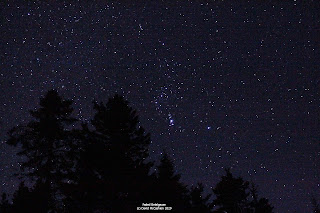Date Time: February 28, 2020 1800-2100 hrs
Weather: Windy and mostly clear, -1C at 1800hrs to no wind and mostly cloudy from 1900-2100, -3C and 56% humidity.
Equipment: Canon Rebel t3 attached to 80mm ED/APO at prime focus. Images processed with Photoshop.
Attendance: David McCashion, Edward O from SJ.
Objective: To image Comet C/2019 Y1 ATLAS which was in Pegasus, low in the west at sundown.
Report:
- A nice pairing of a slender waxing crescent Moon and Venus in the evening sky.
- By the time it got dark, around 1944 hrs, a thin layer of clouds started moving in, and Comet Atlas had moved below the treeline, in the western sky. Took one image and stars could be seen through the thin clouds, but the comet did not stand out.
- Shortly after the Comet Atlas search, clouds took over most of the sky. Tried for Comet C/2017 T2 PANSTARRS, but clouds moved into that part of the sky too. Went inside for about an hour, then tried again just before 2100hrs. There was a short break in the clouds, in the NW sky, where T2 Panstarrs was located. Took a few images, then clouds moved back in. Comet was located near the W of Cassiopeia on the Perseus side. Ed noted that this comet appears to be mostly white, where most comets appear greenish in images, with a lesser percentage being blue. Two thin tails appear to be radiating from the 11 o'clock positions and the 10 o'clock positions. Comet is now heading in the direction of Ursa Major, where it should brighten even further by May of this year.

Image cropped and over-exposed to better show coma and tail. Single shot, 30 second, ISO 6400.

Uncropped and over-exposed. Single shot, 30 second, ISO 3200. Large circular camera aberration in upper right.
- Due to fast moving clouds, had to rush focusing camera, and this resulted in slightly out of focus images. There was simply no time to fine tune the focus. Also, a high thin layer of clouds also affected image quality.
- Seen one south to north, bright satellite, and no shooting stars.











